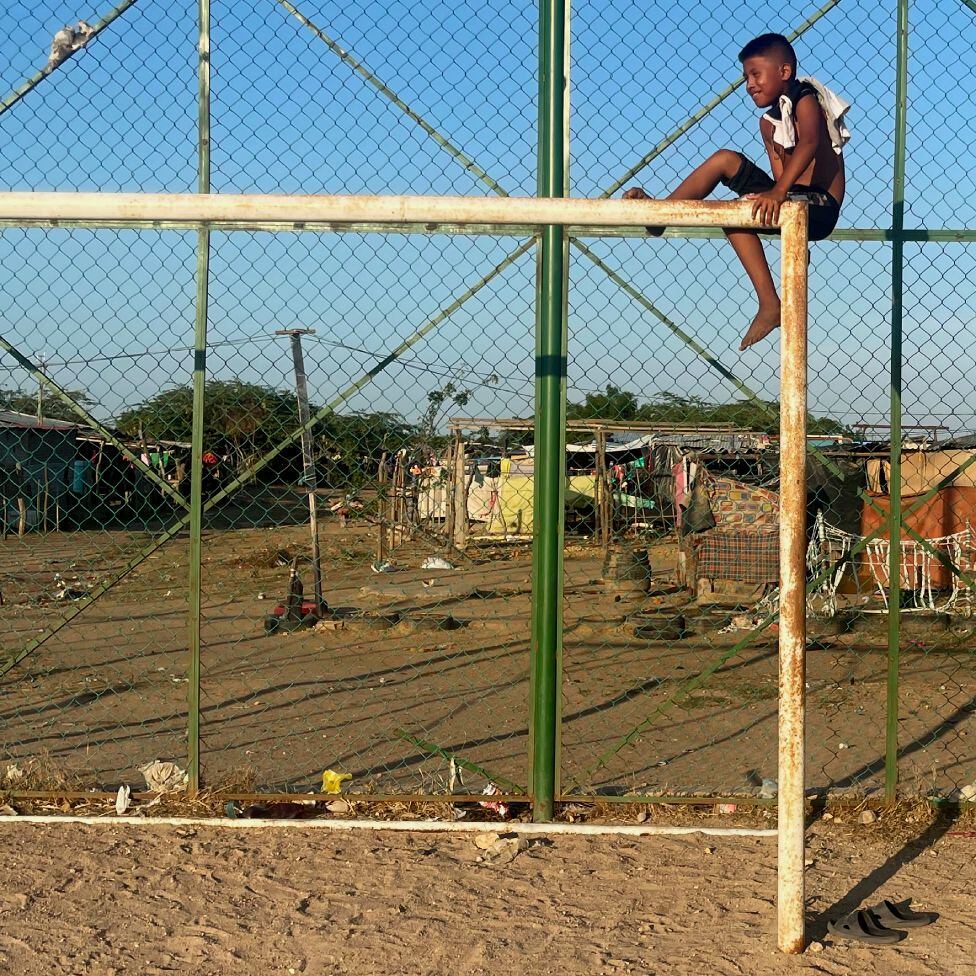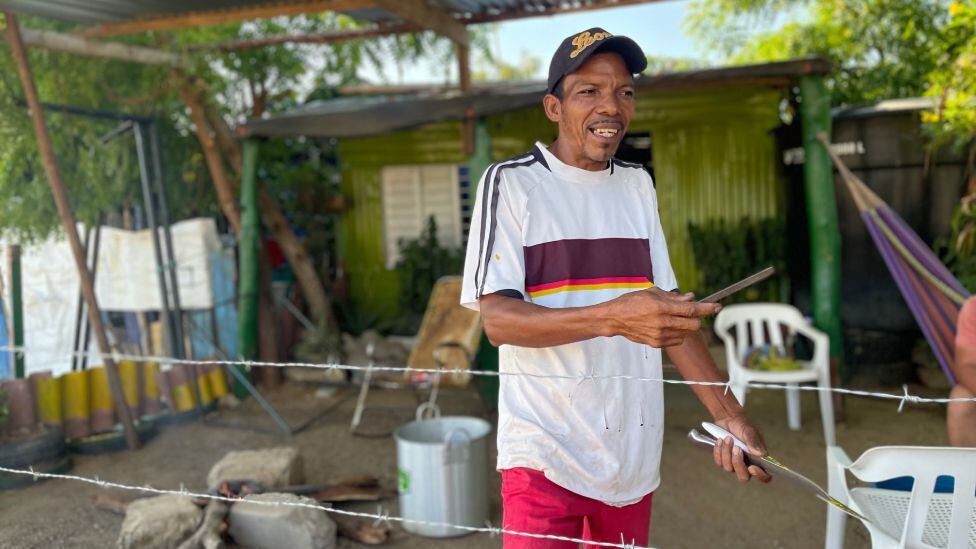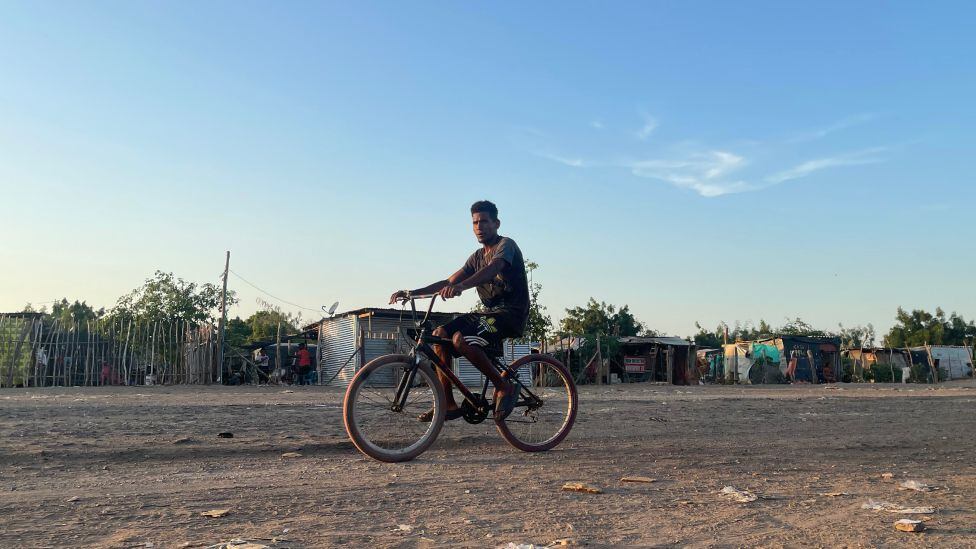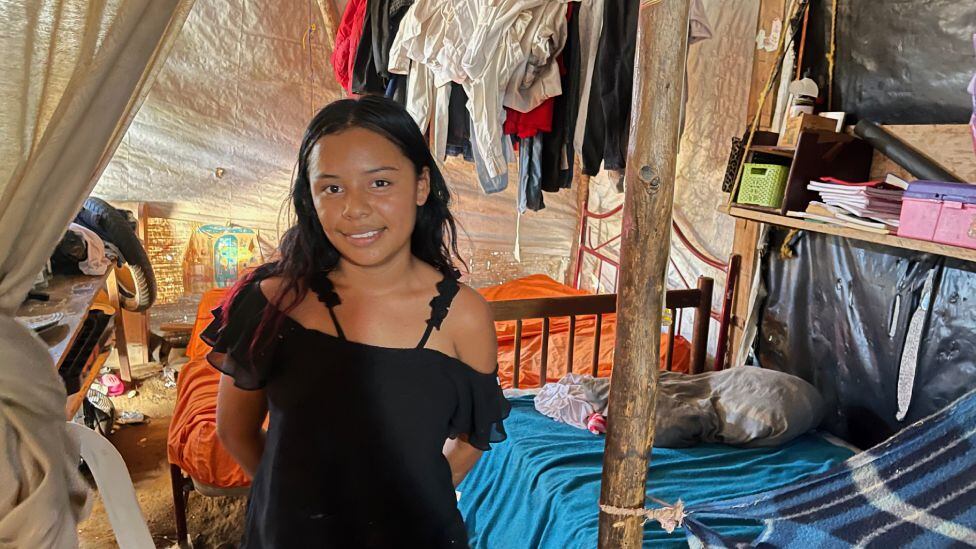Her name is Gelimar del Carmen Palmar, but they call her “Sweet”. She is 18 years old and the ends of her hair are painted red. She wants to be a teacher and a psychologist.
The walls of his house are made of plastic bags and sacks. She sleeps in the same bed with two of her sisters, at the foot of her brothers, who are four and share the same mattress.
LOOK: The man whose modest house was trapped in one of the most luxurious constructions in Miami because he refused to sell it
“But not because I live here I feel less“, she says. “I feel proud of myself, because I never thought that I would live like this and be able to bear so much.”
sweet lives in Tracka huge settlement of Venezuelan migrants in Maicao, in La Guajira Colombian. It is estimated that between 12,000 and 15,000 people live there. They have no electricity or water and they are not allowed to build formal houses, with concrete walls, because the shelter it’s supposedly temporary.
This used to be the airport of Maicao, a thriving commercial city in decline.
The rise of Maicao, a commercial city where 97% of employment is informal, was interrupted in the 1990s as a result of drug trafficking, displacement and armed conflict.
The airport, opened in the 1950s, ended up abandoned at the turn of the century after flights stopped. After several occupation attempts and forced evictions, seven years ago a community managed to settle in the control tower, of which not even the foundations remain.
They called it the Tower of the Majayura. Today that is Manzana 1 of La Pista, the settlement where thousands of Venezuelan families have arrived in the last four years, most of them from the neighboring state of Zulia, fleeing the economic crisis.
“The Track is like one more obstacle that we are going to pass in our lives and that we can cross because we are warriors, we are fighters.“Dulce says.
“The good thing -he adds- is that here you don’t feel the discomfort of being looked at, that Venezuelans [son] thieves. No. Here we are all brothers and that’s what’s cool.”
Dulce is about to graduate from school. Before, she wanted to be a police officer, but thanks to the classes and activities of “A heart without borders”, a foundation of the Marist Brothers in La Pista, she realized that she wants to be a teacher and psychologist.
“I love Put myself in someone else’s place and be able to help them“he points out.
Dulce and her friends are preparing a contemporary dance choreography. If she’s not at school or teaching at the Foundation, she’s learning the dance. “We had never learned something like this, what nerves,” she says.

One of many settlements
La Pista is just one of 42 migrant settlements in Maicao. In Uribia, a nearby municipality, there is also a shelter in an abandoned airport where more than 10,000 migrants live.
Of the seven million Venezuelans who left the country, just over three million are in Colombia. Official figures report that about 200,000 are in La Guajira and almost half of them in Maicao.
The peninsula of La Guajira is a desert the size of Haiti or Belgium in which the border between Colombia and Venezuela blurs.
More than half the people are indigenous Wayuu, but there is also an influential Arab community. The vast majority of the population is binational: they made a living from border exchange.
For both countries, this is the poorest region, with the highest rate of unsatisfied basic needs. Although all services are precarious, access to drinking water is the great tragedy: coverage barely reaches half of the people, according to official figures.

Added to poverty is the proliferation of armed groups, which use the porous border to traffic drugs.
“Migrants stay in Maicao because they don’t have the chance to move anymore,” says Alejandra Castellanos, head of the Maicao office of UNHCR, the UN refugee agency.
“They arrive here and it’s their turn to stay. In addition to the fact that, of course, they have a connection with this territory and are close to their people who remained in Venezuela. Many come and go, because the structural conditions are difficult in both countries. The question is where to survive and the answer is in a different place each time. Migration continues to increase.”

Cooperation that is not enough
Many of the families that live in La Pista are headed by a woman.
Most of them are garbage recyclers. Others sell coffee or handicrafts in the city and many more work in the salt water collection and sale system, the “aguaeburro“, which is supported by donkeys that pull carts with tanks and is used for bathing and washing dishes.
The runway stretches for two kilometers long and is crossed by the wide avenue where planes used to take off and land.
The asphalt is worn, hardly flat. The 12 settlement blocks they spread to the sides. An inclement sun for most of the day makes the space a quiet, calm one, through which motorcycles and motorized tricycles pass.
The few cars that travel are those of international cooperation, which brings together some 30 multilateral organizations in Maicao.

Dérmides Tolosa is a social leader in La Pista. Of Colombian origin, he lived almost all of his life in Venezuela. He has been here for eight years, where he created a thriving business selling coffee on the street. It is, as they are told in the world of cooperation, a “returned”.
While sharpening some knives with which she is going to prepare a sancocho for the community, Tolosa, who wears a cap from the Leones de Caracas baseball team, makes a vehement criticism of humanitarian aid: “They should help create companies, push the migrant, and not just dedicate yourself to giving them”.
“But they do not want the cow that gives them milk to die. It is convenient for them that one continues in poverty. They spend unnecessary money on aid when they could create microenterprises that really take the migrant out of need“, he maintains.
Castellanos, from Acnur, gives his opinion: “Vulnerability is so high that no matter how much humanitarian assistance there is, it is not enough to solve the survival of people (…) The State is responsible for guaranteeing access to human rights ( …) Cooperation will always be complementary”.
Tolosa and Castellanos agree that one of the great problems that La Pista experiences is the number of children who cannot attend school, spend their days wandering and are threatened by crime, that can recruit them or bring them closer to consumption.

The problem with the children
Yusmelina Ávila is a community leader in Manzana 4, where she manages a training center for children called Aldeas.
Ávila graduated as a nurse in Venezuela, but in Colombia she has not been able to validate her title. She then works with her husband in the production and sale of peto, a sweet corn.
A few months after emigrating, her 9-month-old baby died from a respiratory crisis. She came to Colombia partly because the health is better, but the Maicao hospital could not save her son.
Today she regrets having received contraceptive treatment, because “I was left with only one child.”

Large families are an essential part of the Wayuu culture. Here at La Pista there are 23-year-old single mothers who have up to ten children. It is estimated that a third of the population here is underage.
“It is assumed that people came here because there are better care services, and yes, Colombia has provided protection, there are contraceptive methods, but people don’t do it, there are people who have given birth twice in the four years they have been in Colombia,” says Ávila.
And there is no school for so many children, nor are the ones that are good enough.
Most have to go to schools in ranches, a unique format in the area, where, according to Ávila, the teachers give priority to the number of children they receive instead of the quality of education. They are paid per registered student.

“Not in all of La Pista are you going to hear the same story,” says Ávila. “Each leader talks about his community, on our block only two children are out of school.”
With the help of Pies Descalzos, a foundation created by the singer Shakirain block 4 they managed to get most of the children of the community out of the school shantytowns and enroll them in formal schools.
In Aldeas, a colorful space with a wooden roof and a sort of open-air classroom, dozens of children receive classes every weekend to learn how to make sanitary napkins and insect repellent, among other things.
Ávila, or “professor Yusme”, as they call her, concludes: “The key so that (the children) do not leave with bad meetings (company) is that they keep busy when they are out of school. Because here they get lost quickly. You have to give them what to do.”

Source: Elcomercio
I am Jack Morton and I work in 24 News Recorder. I mostly cover world news and I have also authored 24 news recorder. I find this work highly interesting and it allows me to keep up with current events happening around the world.

:quality(75)/cloudfront-us-east-1.images.arcpublishing.com/elcomercio/GNKMJWD6KJDJNLOU3JXYCFBVQI.jpg)





